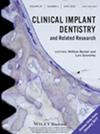The Reliability of CBCT to Assess Quality of Augmented Bone After Lateral Sinus Floor Elevation With Xenografts: A Retrospective Analysis
Abstract
Objetives
This study aimed to explore the reliability of cone beam computed tomography (CBCT) in evaluating the quality of augmented bone after lateral sinus floor elevation (LSFE) with xenografts.
Materials and Methods
Thirty-six patients with lost maxillary molars were included, with half of whom received LSFE with xenografts and staged implant placement, and the other half showed no vertical bone defects and underwent implant placement directly. A total of 36 implants were included, with 18 implants in each group. A CBCT exam was taken before implant placement to acquire data on mineral quality at the future implant site, including bone mineral density (BMD), various microstructure indices, and gray values (GVs) within different threshold ranges. Augmented bone biopsies were collected during implant preparation. The microstructure indices and histological characteristics of the biopsies were evaluated by micro computed tomography (μCT) and histological staining. An implant-oriented volume of interest for CBCT analysis was established to co-locate the CBCT-measured data and the biopsy-related data using 3DSlicer. A Spearman rank correlation test was used to analyze the relationship between CBCT-measured data and the biopsy-related data.
Results
μCT-measured microstructure indices of the augmented bone (BV/TV and Tb.Th) were significantly correlated with new bone area (BV/TV, p = 0.035, r = 0.498; Tb.Th, p = 0.027, r = 0.520). No correlation was found between the CBCT-measured and μCT-measured microstructure indices. CBCT-measured BMD and microstructure indices hardly showed any correlation with histological indices (p > 0.05). When the threshold was set from 0 to 50, the mean GVs were significantly, positively correlated with new bone area (p = 0.041, r = 0.486), and bone substitute area was positively correlated to the mean GVs of higher threshold (range 60–255, p = 0.048, r = 0.472; range 70–255, p = 0.009, r = 0.593).
Conclusions
CBCT without bone substitute segmentation was not reliable for evaluating the quality of xenogenic augmented bone after LSFE. The influence of the xenogenic substitute on CBCT analysis can be reduced by setting a low GV threshold. The bone substitute segmentation strategy may present a new way to increase the reliability of CBCT in evaluating xenogenic augmented bone.

 求助内容:
求助内容: 应助结果提醒方式:
应助结果提醒方式:


